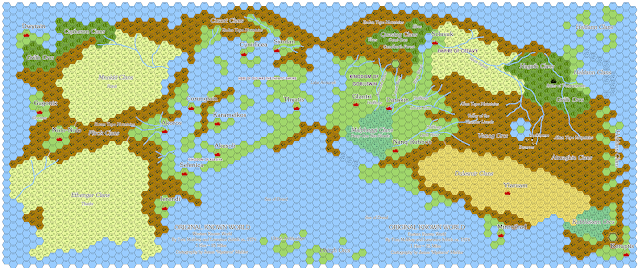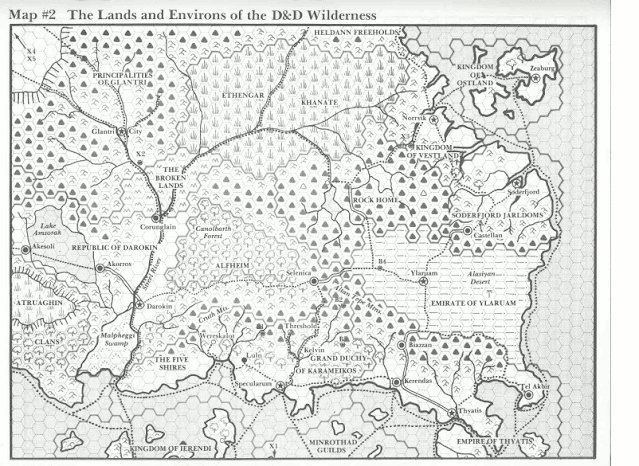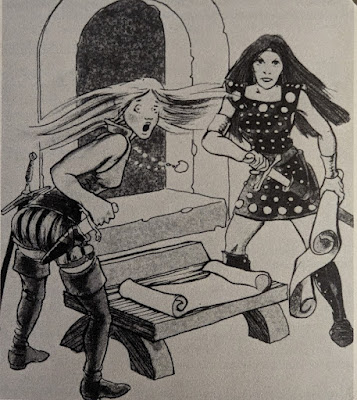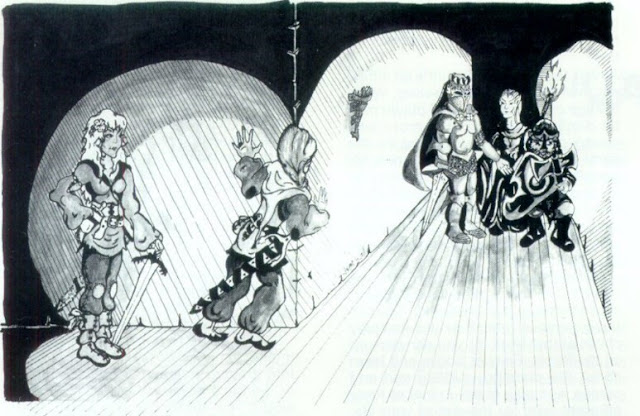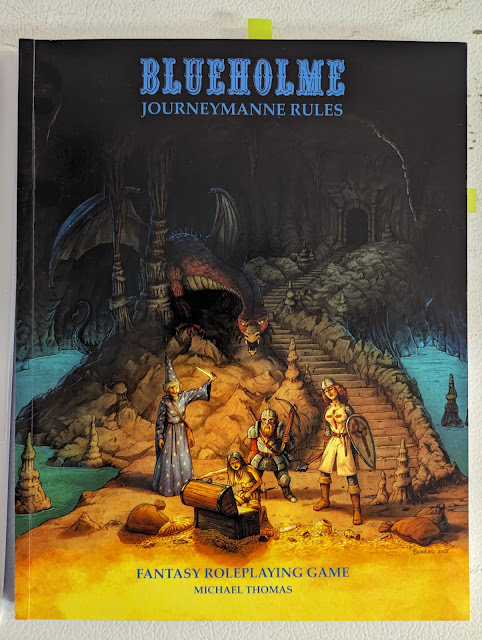I mentioned earlier in this year that my oldest son's group is running through ALL editions of D&D to celebrate 50 years of Dungeons & Dragons. They made characters, and they are taking them through each edition. They have done OD&D, Basic and they are now ready for 1st Edition Advanced. The characters are now 2nd to 4th level, but there are only 5 of them. And they want me to run an AD&D game for them.
Last week I finally figured out what I am going to run. They will go through the Orange version of module B3 Palace of the Silver Princess.
I will explain its infamy to them and run it like it was 1981 for them. So, a mix of B/X and AD&D. Just like we did it. I'll talk more about the adventure, but for now, I want to focus on a small side matter with the adventure(s).
That is, who exactly are the thieves, Duchess and Candella?
In Search of...Duchess and CandellaIn both versions of the adventure, you encounter two thieves pretending to be Lady Maidservants. Well... not convincingly, since they know very little about what a maidservant does or where anything in the castle is. But they are earnest and "very attractive" and ask to join the party.
Now, I always thought that "Duchess" was the dark-haired one and "Candella" the light-haired one. Largely because I thought the dark-haired one looked like a Duchess and Candella is said to have a string of pearls on her. The orange version gives us their ages as 18 for Duchess and 20 for Candella.
I always liked that art. You are catching two thieves almost red-handed, and the look of surprise on Candella's face and her hair flying about was just great.
They became minor recurring NPCs in my games. Showing up, stealing something here and there, and then disappearing again. If the PCs were ever tossed into jail, then sure enough, Duchess and Candella were already there.
I had not thought about them much, and they certainly don't get the ink that the likes of Aleena or Morgan Ironwolf get, but they were/are fun NPCs, and I wanted to know more about them. Turns out I am not the only one.
What does the Web Say?
There are a few links worth visiting and following up on. First is Greyhawk Musings: On Duchess and Candella. This is a great place to start due to its thoroughness. In fact, this blog is a treasure trove of information on them, and I respect David Leonard for that. He speculates that the dark-haired woman thief in G3, The Hall of the Fire Giant King, is Duchess now 11th level. This begs the question, what happened to Candella? Side note: I used that very same thief as a recurring character when I ran G3, but for me, it was Evelyn the Princess Escalla. But I appreciate what he is doing here. Like me, he equates Duchess with the dark-haired woman and Candella with the light-haired one.
We learn from no less of a luminary himself, Frank Mentzer, that these two figures were not just Jean Well's characters; they were her favorite duo of characters. She also did the art of them in Polyhedron #4.
Sadly, we can't ask Wells herself, as she passed away in 2012.
Greyhawk lore master Jason Zavoda made some similar observations and connections for Greyhawk.
I mentioned I was not the only one to find these two fun. They have appeared in more recent products as well. Or at least homages to them.
Candella, sans Duchess, appears on the cover of Blueholme.
She is the one getting the treasure. Wearing the same outfit as Candella at least.
In a minor cameo, but also a cover, no less, they are part of the new D&D Companion Project. I hope to have more on that soon.
And as I mentioned above, the 11th-level thief from G3 Hall of the Fire Giant King might also be Duchess, without Candella.
Duchess and Candella in Other Adventures
B12 Queen's Harvest is another Basic-level adventure. This time though the "B" is from the BECMI flavor of Basic and not the BX one.
Very early on in this Carl Sargent-penned adventure from 1989, we are introduced to two thieves, Erren and Sarrah, on pages 6-7. Their ages and appearances line up with Candella and Duchess, even if their stats don't quite match, though. It is not a stretch of the imagination to assume that Candella and Duchess also have other aliases. They are presented in an NPC Mini-Capsule, so they are important to the adventure, though no other details are given.
The fan module by Agathokles, The Dymrak Dread, makes this connection solid with Sarrah, now known as "the Duchess," and part of the Thieves Guild, and her friend Erren Candella. Here they are 5th and 6th level respectively. This adventure also has Orcus and witches in it, so it is worth my coming back to.
Another adventure to feature them, and this time by name, is the Palace of the Golden Princess, an homage to the original (Orange) Palace of the Silver Princess and Jean Wells herself. There are 5e and OSE versions of the adventure, and they are tied to a comic series taking place in a land inspired by the map in the Original B3 Palace of the Silver Princess. There are even some allusions (in an oblique way) to the Return to the Keep on the Borderlands.
They also briefly appear in Mr. Welch's Mystara Player's Guide for 5e, notably under Mystara's Most Wanted.
Thought their biggest feature run has been in the various Folio Black Label adventures. Most notably in Folio: Black Label #10 and The Complete Folio Black Label.
In The Complete Folio Black Label (covering Black Label 1-6 with extras), nearly every piece of art features our daring duo in all sorts of predicaments throughout all the adventures. They are also rendered by various artists like Brian Brinlee, Peter Bradley, and Simon Adams, among others. Folio: Black Label #4 and Folio: Black Label #5 even feature them on the cover. Honestly, I bought a bunch of these just to see how much Candella and Duchess art there was in them.
Another artist whose work has been featured in the Folio: Black Label books is Domenico Neziti. He has done so many pieces of Duchess and Candella that I am giving him his own space below.
Here are a few of his pieces from his Instagram page.
And another I could not find on his Instagram.
 |
| Domenico Neziti "Demon Bait" |
He clearly has these two down, with some more on his DeviantArt page.
With new books out like Folio: Black Label series it is easy to see how these two have had all sorts of adventures. I can see something akin to distaff versions of Fafhrd and the Gray Mouser, though maybe less magic. Likely a bit closer to The Rat Queens. When I used them in games I always made Candella closer to the Thief-Acrobat concept and Duchess maybe a little closer to a Thief-Assassin. But I don't get "evil" off of either of them, really. Plus, Duchess doesn't have the strength score to be an assassin. Maybe more fighter-thief.
Duchess and Candella in my Games
I have used them in the past, as I mentioned, but never to the extent I have some other characters and certainly not to the level some other gamers have.
Given all the art out there, they have certainly had a lot of adventures, and some that look outright crazy. But these two seem like fun characters to have "madcap adventures." I mean, is Morgan Ironwolf going to pretend to be half-naked bait for a demon? No, I don't see it. I'd love to use these two in my Forgotten Realms adventures but honestly they are so Mystara/Oerth feeling for me I can't see moving them over any easier than I could move the B-modules over.
I have at least figured out how they met. This came up in an adventure before. They were both, independently trying to steal this ruby, from the local guild-mistress of thieves. They didn't know the other was also trying, nor did either know this was the guild mistress. They failed, and the guild mistress, Amara, impressed by their attempt or something else, took them in and made them work together. The two became good friends, and their careers began. In my mind, Candella had been a tavern wench who had become tired of watching adventurers coming in with ill-gotten gains when she could have all that gold. Duchess' background is a bit darker. She was a servant girl working for a Baron and Baroness. The Baroness had accused her of stealing a necklace, but she had not. The Baron, who was broke, had sold it to cover some of his debts and suggested she could work off her guilt in his bed chamber. When she refused, he got violent, and she ran to escape him, and he fell down the stairs to his death. Knowing she would be blamed and likely executed, she ran. She thinks she is still wanted for the Baron's murder. She isn't; no one ever looked for her. In fact, the Baron's debt was so great that the local authorities had plenty of other suspects. The Baroness died soon after in the home of a relative.
I know, according to the art above, that Candella gains some Boots of Flying, and Duchess gets a huge magic sword.
Since my oldest is running his group through all of the editions of D&D I'll also do versions of them for every edition. Say 2nd level for D&D Basic/Expert, 4th level for AD&D 1st, 8th level for AD&D 2nd Editon, 12th level for D&D 3.x, 16th level for D&D 4e Essentials (better Rogues), and 20th for D&D 5th Edition. That should be fun, really. Course I'll need some good prestige classes when I get to 3.x. I think I'll post them when I get around to stating them all up.
While I will keep them at the same level, at any given time, Candella is about 600 XP ahead of Duchess.
 |
Candella and Duchess for B/X. Art by Brian Brinlee and Domenico Neziti,
Vitruvian Character Sheets Blog of Exalted Deeds |
While reading up on them, I saw one person online refer to them as a couple of "party girls." I mean, sure, that fits. The vibe I have always had with them was they were both adventuresses out for a bit of fun and hopefully score some treasure. Ok, a lot of treasure. Though at least one academic dissertation places them in the role of temptresses. I suppose that would work too, though not how I would play them.
Have you used these two in your games? How did it work for you? What happened with them?
Links
